16 Nuts and Seeds High in Protein

Nuts and seeds are a heart-healthy snack. Almonds, in particular, have been shown to lower cholesterol. In addition to being a good source of fiber and healthy fats, nuts can also be a good source of protein.
The current daily value (DV) for protein is 50 grams per day. (1) One ounce (1oz) of nuts or seeds is typically equivalent to a handful, or 2-3 tablespoons. Most nuts provide between 8 and 18% DV of protein per 1oz handful.
High protein nuts and seeds include hemp seeds, pumpkin seeds, peanuts, almonds, pistachios, sunflower seeds, flax seeds, sesame seeds, chia seeds, cashews, and more. Below is a list of 16 nuts and seeds high in protein. For more, see the extended list of less common nuts and seeds high in protein.
List of High Protein Nuts
 1 Hemp Seeds
1 Hemp Seeds| Protein per Oz | Protein per 100g | Protein per 200 Calories |
|---|---|---|
| 9g (18% DV) | 31.6g (63% DV) | 11.4g (23% DV) |
 2 Squash and Pumpkin Seeds
2 Squash and Pumpkin Seeds| Protein per 1oz Handful | Protein per 100g | Protein per 200 Calories |
|---|---|---|
| 8.5g (17% DV) | 29.8g (60% DV) | 10.4g (21% DV) |
 3 Peanuts (Dry Roasted)
3 Peanuts (Dry Roasted)| Protein per Oz | Protein per 100g | Protein per 200 Calories |
|---|---|---|
| 6.9g (14% DV) | 24.4g (49% DV) | 8.3g (17% DV) |
Peanuts are actually legumes, but are listed here since they are nuts in the culinary sense.
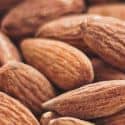 4 Almonds
4 Almonds| Protein per 1oz Handful | Protein per 100g | Protein per 200 Calories |
|---|---|---|
| 6g (12% DV) | 21.2g (42% DV) | 7.3g (15% DV) |
 5 Pistachios (Dry Roasted)
5 Pistachios (Dry Roasted)| Protein per 1 Oz Handful | Protein per 100g | Protein per 200 Calories |
|---|---|---|
| 6g (12% DV) | 21.1g (42% DV) | 7.4g (15% DV) |
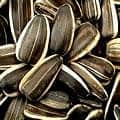 6 Sunflower Seeds (Dry Roasted)
6 Sunflower Seeds (Dry Roasted)| Protein per Oz | Protein per 100g | Protein per 200 Calories |
|---|---|---|
| 5.5g (11% DV) | 19.3g (39% DV) | 7.1g (14% DV) |
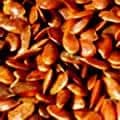 7 Flax Seeds
7 Flax Seeds| Protein per Oz | Protein per 100g | Protein per 200 Calories |
|---|---|---|
| 5.2g (10% DV) | 18.3g (37% DV) | 6.9g (14% DV) |
 8 Sesame Seeds
8 Sesame Seeds| Protein per Oz | Protein per 100g | Protein per 200 Calories |
|---|---|---|
| 4.8g (10% DV) | 17g (34% DV) | 6g (12% DV) |
 9 Chia Seeds
9 Chia Seeds| Protein per oz(~2 Tblsp) | Protein per 100g | Protein per 200 Calories |
|---|---|---|
| 4.7g (9% DV) | 16.5g (33% DV) | 6.8g (14% DV) |
 10 Cashews (Dry Roasted)
10 Cashews (Dry Roasted)| Protein per 1 Oz Handful | Protein per 100g | Protein per 200 Calories |
|---|---|---|
| 4.3g (9% DV) | 15.3g (31% DV) | 5.3g (11% DV) |
 11 Walnuts
11 Walnuts| Protein per Oz | Protein per 100g | Protein per 200 Calories |
|---|---|---|
| 4.3g (9% DV) | 15.2g (30% DV) | 4.7g (9% DV) |
 12 Hazelnuts (Filberts) (Dry Roasted)
12 Hazelnuts (Filberts) (Dry Roasted)| Protein per 1 Oz Handful | Protein per 100g | Protein per 200 Calories |
|---|---|---|
| 4.3g (9% DV) | 15g (30% DV) | 4.7g (9% DV) |
 13 Pine Nuts
13 Pine Nuts| Protein per Oz | Protein per 100g | Protein per 200 Calories |
|---|---|---|
| 3.9g (8% DV) | 13.7g (27% DV) | 4.1g (8% DV) |
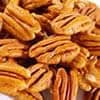 14 Pecans
14 Pecans| Protein per Oz | Protein per 100g | Protein per 200 Calories |
|---|---|---|
| 2.6g (5% DV) | 9.2g (18% DV) | 2.7g (5% DV) |
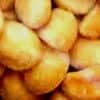 15 Macadamia Nuts
15 Macadamia Nuts| Protein per 1 Oz Handful | Protein per 100g | Protein per 200 Calories |
|---|---|---|
| 2.2g (4% DV) | 7.9g (16% DV) | 2.2g (4% DV) |
 16 Dried Coconut
16 Dried Coconut| Protein per Oz | Protein per 100g | Protein per 200 Calories |
|---|---|---|
| 2g (4% DV) | 6.9g (14% DV) | 2.1g (4% DV) |
Extended List of Protein Rich Nuts and Seeds
| Food | Serving | Protein |
|---|---|---|
| 1 Butternuts (Dried) | 1oz | 14% DV (7.1g) |
| 2 Black Walnuts (Dried) | 1oz | 14% DV (6.8g) |
| 3 Safflower Seeds | 1oz | 9% DV (4.6g) |
| 4 Lotus Seeds | 1oz | 9% DV (4.4g) |
| 5 Hickory Nuts (Dried) | 1oz | 7% DV (3.6g) |
| 6 Pilinuts (Dried) | 1oz | 6% DV (3.1g) |
| 7 Ginkgo Nuts (Dried) | 1oz | 6% DV (2.9g) |
| 8 Acorns (Dried) | 1oz | 5% DV (2.3g) |
| 9 Beechnuts (Dried) | 1oz | 4% DV (1.8g) |
| 10 Coconut Water | per cup | 3% DV (1.7g) |
| 11 Breadfruit Nuts (Boiled) | 1oz | 3% DV (1.5g) |
About the Data
Data for the curated food lists comes from the USDA Food Data Central Repository.
You can check our data against the USDA by clicking the (Source) link at the bottom of each food listing.
Note: When checking data please be sure the serving sizes are the same. In the rare case you find any difference, please contact us and we will fix it right away.
About Nutrient Targets
Setting targets can provide a guide to healthy eating.
Some of the most popular targets include:- Daily Value (%DV) - The daily value (%DV) is a general guideline for consumption that will prevent deficiency of a particular nutrient in most people. The %DV refers to the percentage of an amount that's found in a single serving of a food. It also accounts for absorption factors. It is set by the U.S. FDA.
- Recommended Dietary Allowance (%RDA) - The RDA sets an average daily dietary intake level that is sufficient to meet the nutrient requirements of nearly all (97.5%) healthy individuals. It's more specific than the daily value, and varies by age and gender. The RDA is set by the US National Instutites of Health.
- Reference Dietary Intake (%RDI) -The reference dietary intake is similar to the recommended daily allowance, but is specific to age and gender. The RDI for amino acids is set by the U.N. World Health Organization.
- Adequate Intake (%AI) - This value is primarily used in reference to omega-3 and omega-6 fats. The Adequate Intake is set by the U.S. Institute of Medicine. Because there is less evidence to determine the ideal targets for consumption of these nutrients, the specific amount is considered to be less reliable. Using the term Adequate Intake, rather than one of the other terms, helps to emphasize that the ideal intake of that particular nutrient has not yet been scientifically determined.
See the Guide to Recommended Daily Intakes for more information.
Want to set your own targets? Sign up for an account and set custom targets in the daily meal planner.From the Nutrient Ranking Tool
Use the ranking tool links below to select foods and create your own food list to share or print.
- Foods High in Protein
- Foods Low in Protein
- Vegetables High in Protein
- Fruits High in Protein
- Vegetarian Foods High in Protein
- Nuts High in Protein
- Grains High in Protein
- Beans High in Protein
- Dairy High in Protein
- Breakfast Cereals High in Protein
- Fast Foods High in Protein
View more nutrients with the nutrient ranking tool, or see ratios with the nutrient ratio tool.
Related
Data Sources and References
Try the recipe nutrition calculator, or daily meal planner.
Create a free account to log and track foods.

